Epigenetic Alteration of the Hailijin Sandstone-Hosted Uranium Deposit and Its Indications on Uranium Metallogenesis in the Songliao Basin, NE China
Abstract
1. Introduction
2. Geological Settings
3. Analytical Methods
- (1)
- Petrographic Identification
- (2)
- Major and Trace Element Analysis
- (3)
- X-Ray Diffraction (XRD) Analysis
- (4)
- Scanning Electron Microscopy (SEM)
4. Results
4.1. Types of Alteration Minerals
- (1)
- Hematitization
- (2)
- Limonitization
- (3)
- Carbonatization
- (4)
- Pyritization
- (5)
- Clay alteration
- (6)
- Baritization
4.2. Alteration Mineral Assemblages
5. Discussion
5.1. Alteration Mineral Formation Sequence
5.2. Alteration Zonation
5.3. Discussion on the Genesis of the Deposit
6. Conclusions
- (1)
- Six types of alteration can be identified in the ore-bearing sandstone of the Hailijin uranium deposit, namely hematitization, limonitization, carbonatization, pyritization, clayization, and baritization. Diagenetic alteration minerals include hematite, clay minerals, II-type (framboidal pyrite) and III-type pyrite (euhedral granular pyrite). Mineralization-related alteration minerals include ankerite, barite, I-type pyrite (colloidal pyrite), and small amounts of kaolinite. Post-mineralization alteration minerals are mainly represented by calcite cement in red sandstones.
- (2)
- The alteration zonation of the Hailijin uranium deposit can be divided into primary red zone, weakly reduced pink zone, moderately reduced grayish-yellow zone, and strongly reduced gray zone. The primary red zone sandstone was formed under arid-semiarid climatic conditions during the Yaojia period. The weakly reduced pink zone, moderately reduced grayish-yellow zone, and strongly reduced gray zone sandstones are the result of varying degrees of reduction by deep-seated reducing fluids acting on the primary red zone sandstone, with the strongly reduced gray zone showing the strongest alteration.
- (3)
- The genesis of the Hailijin uranium deposit is closely linked to the uranium-rich mildly acidic reducing fluids originating from the Lower Cretaceous Jiufotang Formation in the Qianjiadian area. During the uranium mineralization period, these fluids migrated upward along the F1 fault, which traverses the Yaojia Formation strata. With changes in the physical and chemical conditions of the system, uranium unloading, precipitation, and enrichment occurred, ultimately resulting in the formation of multi-layered and tabular-shaped uranium ore bodies.
Author Contributions
Funding
Data Availability Statement
Acknowledgments
Conflicts of Interest
References
- IAEA. Descriptive Uranium Deposit and Mineral System Models; International Atomic Energy Agency: Vienna, Austria, 2020; pp. 168–199. [Google Scholar]
- Wu, Z.J.; Han, X.Z.; Lin, Z.X.; Li, Z.N.; Ji, H.; Yin, D.F.; Jiang, Z.; Hu, H. Tectonic, Sedimentary, and Climate Evolution of Meso-Cenozoic Basins in North China and Its Significance of Coal Accumulation and Uranium Mineralization. Geotecton. Metallog. 2020, 44, 710–724. [Google Scholar]
- Wang, S.Y.; Cheng, Y.H.; Xu, D.H.; Miao, P.S.; Jin, R.S.; Zhang, T.F.; Xu, Z.L.; Cheng, X.Y.; Zhao, L.; Li, C.H.; et al. Late Cretaceous-Cenozoic Tectonic-Sedimentary Evolution and U-Enrichment in the Southern Songliao Bain. Ore Geol. Rev. 2020, 126, 103786. [Google Scholar]
- Kyser, T.K.; Cuney, M. Geochemistry of Uranium Deposits. Miner. Depos. Can. 2008, 4, 631–678. [Google Scholar]
- Gauthier-Lafaye, F. The Role of Geodynamics in The Formation of Uranium Deposits in Sedimentary Basins. Ore Geol. Rev. 1996, 11, 165–190. [Google Scholar]
- Dahlkamp, F.J. Uranium Deposits of the World: USA and Latin America; Springer: Berlin/Heidelberg, Germany, 2010; pp. 149–233. [Google Scholar]
- Xia, Y.L.; Zheng, J.W.; Li, Z.Y.; Li, L.Q.; Tian, S.F. Metallogenic Characteristics and Metallogenic Model of Qianjiadian Uranium Deposit in Songliao Basin. Miner. Depos. 2010, 29, 154–155. (In Chinese) [Google Scholar]
- Huang, S.H.; Qin, M.K.; Liu, Z.Y.; Zhang, L.L.; Guo, Q.; Jia, L.C.; Jiang, W.J.; Liu, J.L.; Dong, Y. Uranium Occurrence and Metallogenic Age for The DL Uranium Mineralized Belt in Qianjiadian Sag, Southwestern Songliao Basin. Geol. Rev. 2022, 68, 817–830, (In Chinese with English Abstract). [Google Scholar]
- Nie, F.J.; Yan, Z.B.; Xia, F.; Li, M.G.; Lu, Y.Y.; Cai, J.F.; Guo, F.N.; Ning, J. Hot Fluid Flows in The Sandstone-Hosted Uranium Deposit in the Kailu Basin, Northeast China. Geol. Bull. China 2017, 36, 1850–1866, (In Chinese with English Abstract). [Google Scholar]
- Rong, H.; Jiao, Y.Q.; Wu, L.Q.; Wan, D.; Cui, Z.J.; Guo, X.J.; Jia, J.M. Origin of The Carbonaceous Debris and Its Implication for Mineralization Within the Qianjiadian Uranium Deposit, Southern Songliao Basin. Ore Geol. Rev. 2019, 107, 336–352. [Google Scholar]
- Ren, Y.S.; Yang, X.Y.; Hu, X.W.; Wei, J.L.; Tang, C. Mineralogical and Geochemical Evidence for Biogenic Uranium Mineralization in Northern Songliao Basin, NE China. Ore Geol. Rev. 2022, 141, 104556. [Google Scholar]
- Feng, Z.Q.; Jia, C.Z.; Xie, X.N.; Zhang, S.; Feng, Z.H.; Cross, T.A. Tectonostratigraphic Units and Stratigraphic Sequences of the Nonmarine Songliao Basin, Northeast China. Basin Res. 2010, 22, 79–95. [Google Scholar]
- Bonnetti, C.; Malartre, F.; Huault, V.; Cuney, M.; Bourlange, S.; Liu, X.; Peng, Y. Sedimentology, Stratigraphy and Palynological Occurrences of the Late Cretaceous Erlian Formation, Erlian Basin, Inner Mongolia, People’s Republic of China. Cretac. Res. 2014, 48, 177–192. [Google Scholar]
- Chen, M.Y.; Nie, F.J.; Xia, F.; Yan, Z.B.; Yang, D.G. Provenance, Sedimentary Environment, Tectonic Setting, and Uranium Mineralization Implications of the Yaojia Formation, SW Songliao Basin, NE China. Minerals 2023, 13, 1053. [Google Scholar] [CrossRef]
- Tian, M.M.; Li, Z.Y.; Zhang, Y.L.; Jia, L.C.; Ning, J.; Li, J.M.; He, H.H.; Tang, G.L. Genetic Mechanism of Tabular-Shaped Orebody of The Hailijin Sandstone-Hosted Uranium Deposit in The Songliao Basin: Constraints on the Clay Mineralogy of Ore-Bearing Sandstone. Minerals 2023, 13, 1324–1340. [Google Scholar]
- Tian, M.M.; Li, Z.Y.; Zhang, Y.L.; Jia, L.C.; Qiu, L.F.; Xing, Z.C.; Ning, J.; Li, J.M.; Tang, G.L.; Lin, X.B. Trace Element and Sulfur Isotopes Characterisitcs Of Pyrite in Hailijin Uranium Deposit and Their Implications to Ore-Forming Properties, Songliao Basin. Uranium Geol. 2024, 40, 119–128, (In Chinese with English Abstract). [Google Scholar]
- Lin, X.S.; Bao, Y.J.; Zheng, N.X.; Han, H.; Guo, G.R. X-Ray Diffraction Analysis Method for the Relative Content of Clay Minerals in Sedimentary; China National Petroleum Corporation: Beijing, China, 1995; pp. 2–10. (In Chinese) [Google Scholar]
- Yao, F.; Yin, S.H.; Zhou, W.D.; Gao, W.J.; Wei, D.Q. General Rules of Analytical Methods for Scanning Electron Microscope; Ministry of Education of the People’s Republic of China: Beijing, China, 2020; pp. 1–12. (In Chinese) [Google Scholar]
- Lin, C.Y.; Wan, D.R. General Rules for Analytical Scanning Electron Microscopy; State Education Commission: Beijing, China, 1997; pp. 1–5. (In Chinese) [Google Scholar]
- Singh, S.; Awasthi, A.K.; Khanna, Y.; Kumar, A.; Singh, B.; Kumar, A.; Popli, C. Sediment Colour As Recorder of Climate and Tectonics: Cenozoic Continental Red Beds of the Himalayan Foreland Basin in India. Catena 2021, 203, 105298. [Google Scholar]
- Xing, Z.C.; Li, Z.Y.; Wang, H.T.; Jia, L.C.; Ning, J.; Tian, M.M.; Liu, W.S.; Wu, D.K.; Lin, X.B. Characteristics, Genesis and Prospecting Significance of Red Sand Body in the Lower Member of Upper Cretaceous Yaojia Formation, Southwestern Songliao Basin. Uranium Geol. 2023, 39, 987–1001, (In Chinese with English Abstract). [Google Scholar]
- Guilbert, J.M.; Park, C.F. The Geology of Ore Deposits; Waveland Press Inc.: Long Grove, IL, USA, 2007; pp. 170–205. [Google Scholar]
- Titley, S.R.; Beane, R.E. Porphyry Copper Deposits. Part II. Hydrothermal Alteration and Mineralization. Econ. Geol. 1981, 75, 214–236. [Google Scholar]
- Evans, A.M. Ore Geology and Industrial Minerals: An Introduction; Black Science: Hoboken, NJ, USA, 1993; pp. 165–203. [Google Scholar]
- Niu, S.D.; Li, S.R.; Santosh, M.; Zhang, D.H.; Li, Z.D.; Shan, M.J.; Lan, Y.X.; Gao, D.R.; Zhao, W.B. Mineralogical and Isotopic Studies of Base Metal Sulfides from the Jiawula Ag-Pb-Zn Deposit, Inner Mongolia, NE China. J. Asian Earth Sci. 2016, 115, 480–491. [Google Scholar]
- Román, N.; Reich, M.; Leisen, M.; Morata, D.; Barra, F.; Deditius, A.P. Geochemical and Micro-Textural Fingerprints of Boiling in Pyrite. Geochim. Cosmochim. Acta 2019, 246, 60–85. [Google Scholar]
- Song, H.; Ni, S.J.; Hou, M.C.; Zhang, C.J.; Shi, Z.Q.; Wang, G.; Yang, B.; Hu, Y.; Chen, Y.J. The Characteristic of Clay Minerals in Sandstone-Type Uranium Deposit in The Yili Basin, NW China And Its Relationship with Uranium Mineralization. Acta Geol. Sin. 2016, 90, 3352–3366, (In Chinese with English Abstract). [Google Scholar]
- Li, J.G.; Zhang, B.; Jin, R.S.; Si, Q.H.; Miao, P.S.; Li, H.L.; Cao, M.Q.; Wei, J.L.; Chen, Y. Uranium Mineralization of Coupled Supergene Oxygen-Uranium Bearing Fluids and Deep Acidic Hydrocarbon Bearing Fluids in the Qianjiadian Uranium Deposit, Kailu Basin. Geotecton. Metallog. 2020, 44, 576–589, (In Chinese with English Abstract). [Google Scholar]
- Huang, S.H.; Qin, M.K.; Liu, Z.Y.; Xiao, J.; Liu, N. Spatiotemporal Relationship Between Hydrocarbon Fluid and Sandstone-Hosted Uranium Deposits in The Qianjiadian Area, Songliao Basin. Geol. J. 2024, 59, 1148–1170. [Google Scholar] [CrossRef]
- Hu, X.W.; Yang, X.Y.; Ling, M.X.; Xu, J.B.; Du, G.F.; Li, Q.C.; Cao, M.Q.; Wu, Z.J. Mineralogical and Geochemical Studies on The Qianjiadian Deposit, Songliao Basin, Ne China: Insights into Multiple Metallogenic Processes in The Sandstone-Type Uranium Deposit. Ore Geol. Rev. 2024, 168, 106050. [Google Scholar] [CrossRef]
- Li, Z.Y.; Liu, W.S.; Li, W.T.; Li, X.D.; Qin, M.K.; Cai, Y.Q.; Zhang, Y.L.; He, S.; Wu, Q.B.; Qiu, L.F.; et al. Exudative Metallogeny of the Hadatu Uranium Deposit in the Erlian Basin, Inner Mongolia. Geol. China 2022, 49, 1009–1047, (In Chinese with English Abstract). [Google Scholar]
- Qiu, L.F.; Li, Z.Y.; Zhang, Z.L.; Wang, L.H.; Li, Z.C.; Han, M.Z.; Wang, T.T. Characteristics of Organic Matter in Lower Cretaceous Ore-Bearing Sandstones and Its Relationship with Uranium Mineralization in The Northern Ordos Basin. Earth Sci. Front. 2024, 31, 281–296, (In Chinese with English Abstract). [Google Scholar]
- Jia, J.M.; Rong, H.; Jiao, Y.Q.; Wu, L.Q.; Wang, Y.; Li, H.L.; Cao, M.Q. Mineralogy and Geochemistry of Carbonate Cement in Sandstone and Implications for Mineralization of the Qianjiadian Sandstone-Hosted Uranium Deposit, Southern Songliao Basin, China. Ore Geol. Rev. 2020, 13, 103590. [Google Scholar] [CrossRef]
- Chen, M.Y.; Nie, F.J.; Fayek, M. Discussion of The Genetic Relationship Between Pyrite and Uranium Mineralization in Sandstone-Type Uranium Deposits in Kailu Basin. Acta Geosci. Sin. 2021, 42, 868–880, (In Chinese with English Abstract). [Google Scholar]
- Li, H.T.; Wu, S.X.; Cai, C.F.; Luo, X.R.; Bao, R.M. Geochemical Characteristics and Origin of Inclusions and Adsorbed Hydrocarbons in Yaojia Formation Sandstones in Qianjiadian Area, The Kailu Basin. Pet. Geol. Exp. 2008, 30, 375–382, (In Chinese with English Abstract). [Google Scholar]
- Zhao, L.; Chen, H.; Cai, C.F.; Jin, R.S.; Wei, J.L. Geochemical Characteristics of Hydrocarbons in Ore-Rich Sandstones in The Qianjiadian Uranium Deposit, Southwestern Songliao Basin. Geol. Bull. China 2022, 41, 498–508, (In Chinese with English Abstract). [Google Scholar]
- Guo, R.B. Assessment of Shale Oil Potential and Predication of Movable Oil of The Upper Jiufotang Formation in Ludong Sag, Kailu Basin. Ph.D. Thesis, China University of Geosciences (Beijing), Beijing, China, 2020; pp. 25–32, (In Chinese with English Abstract). [Google Scholar]
- Zhang, M.Y.; Zheng, J.W.; Tian, S.F.; Xia, Y.L.; Liu, H.B. Research on Existing State of Uranium and Uranium Ore-Formation Age at Qianjiadian Uranium Deposit in Kailu Depression. Uranium Geol. 2005, 21, 213–218, (In Chinese with English Abstract). [Google Scholar]
- Wang, C.D.; Hao, X.F.; Yang, D.G.; Ning, J.; Wong, H.J.; Yan, Z.B.; Zhang, S.H.; Wu, F. Cenozoic Diabase and Its Relation to Metallization of Sandstone Type Uranium Deposit in Southern Songliao Basin. J. Jilin Univ. (Earth Sci. Ed.) 2023, 11, 53. [Google Scholar]
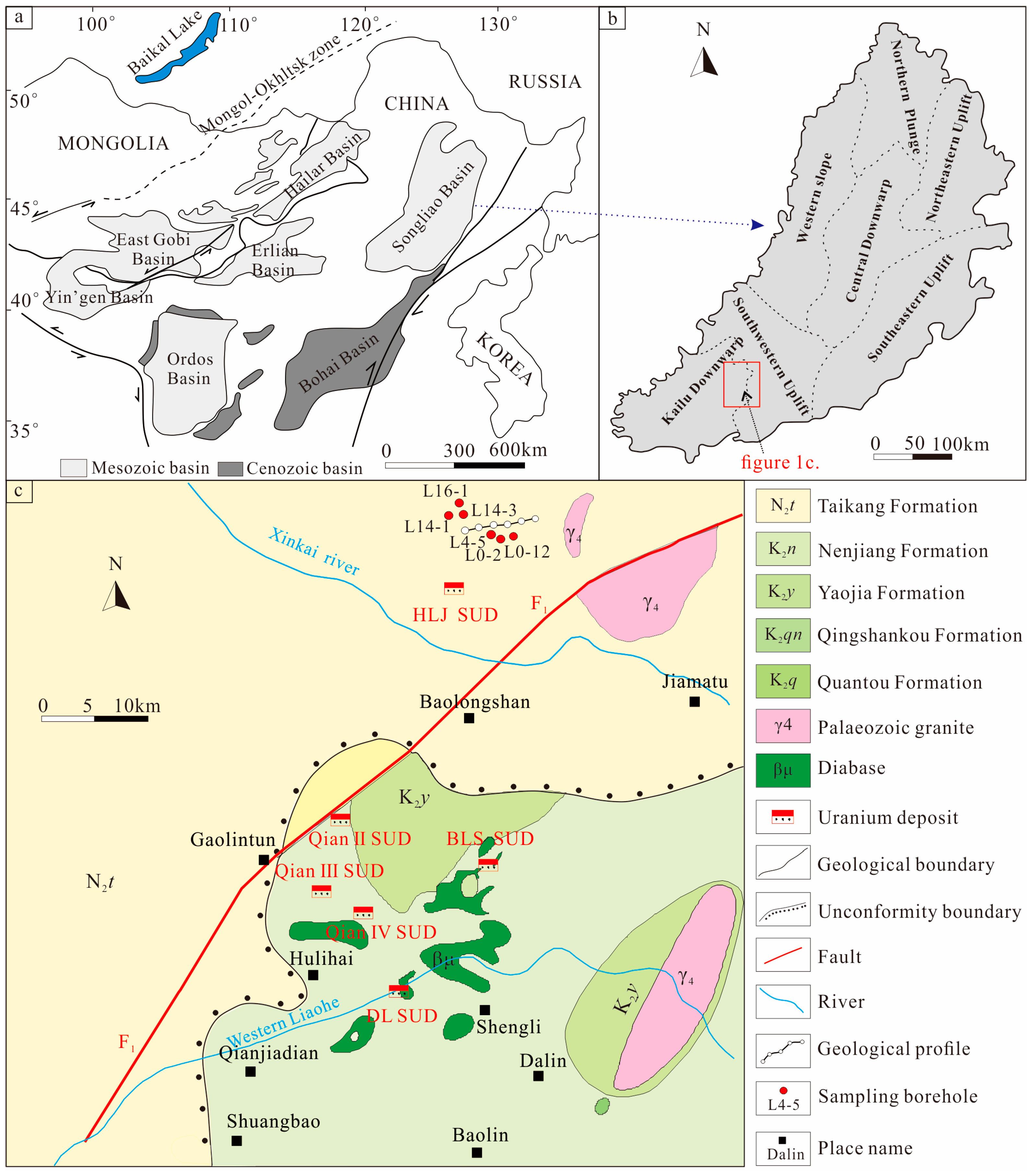
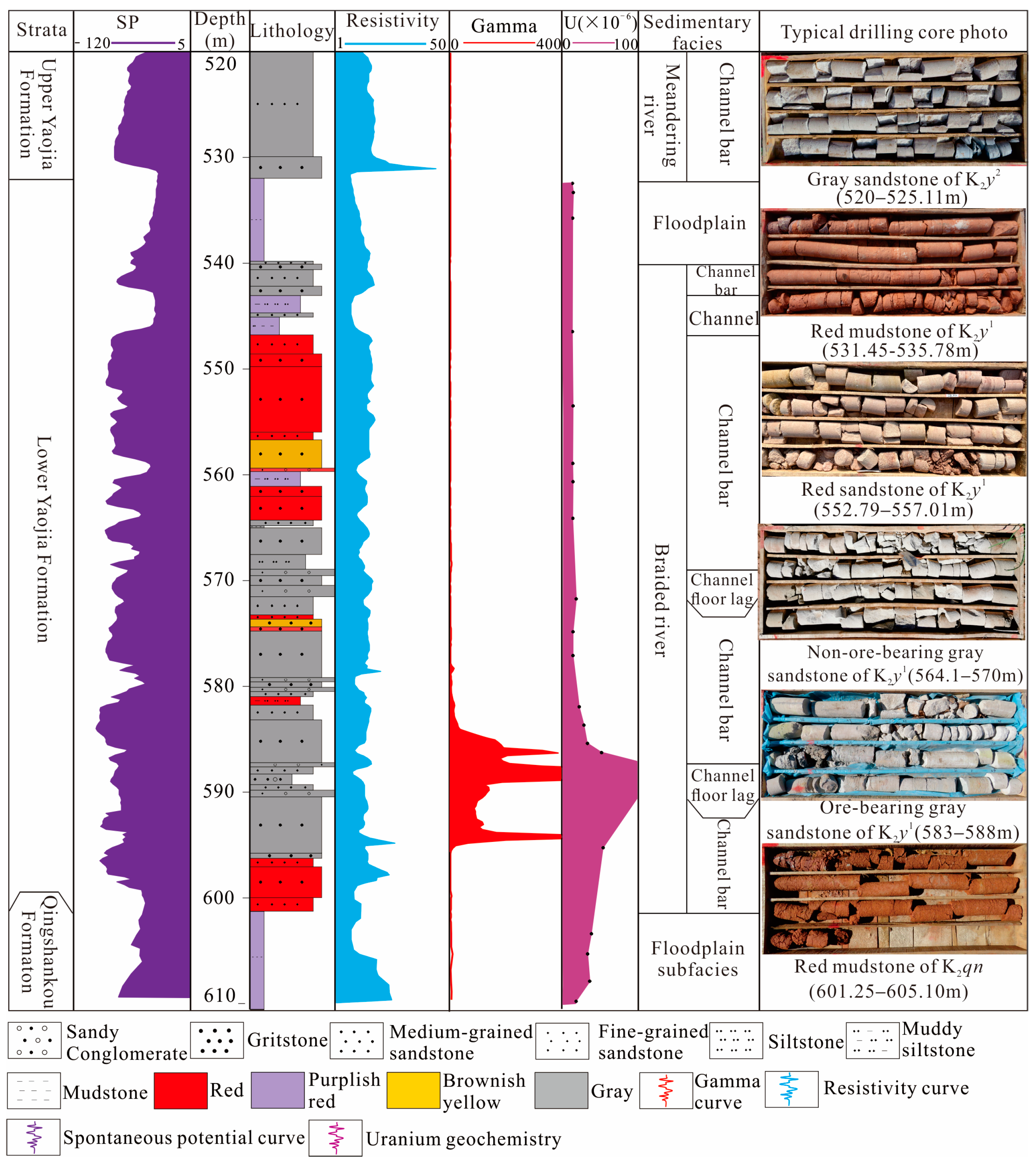


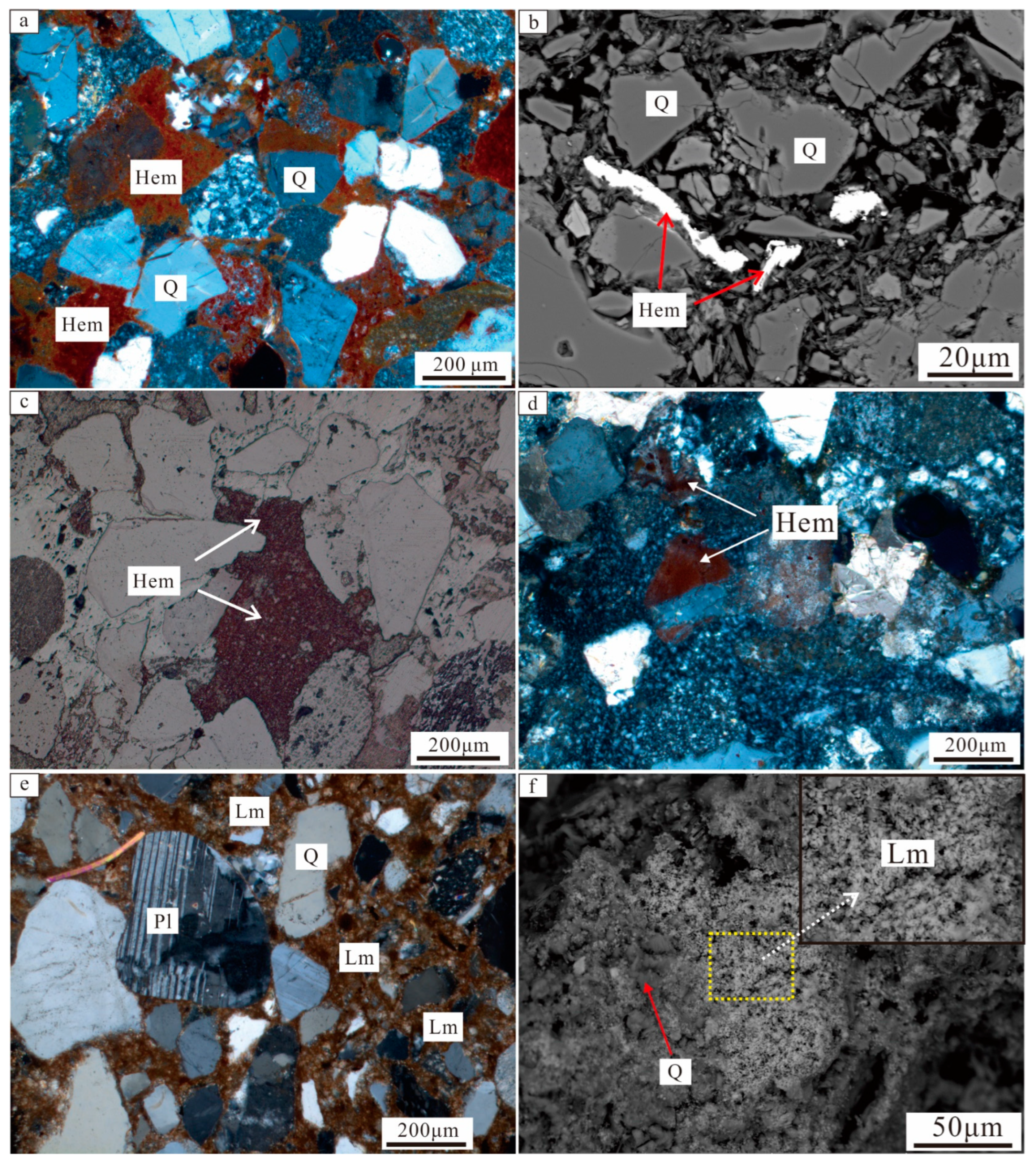
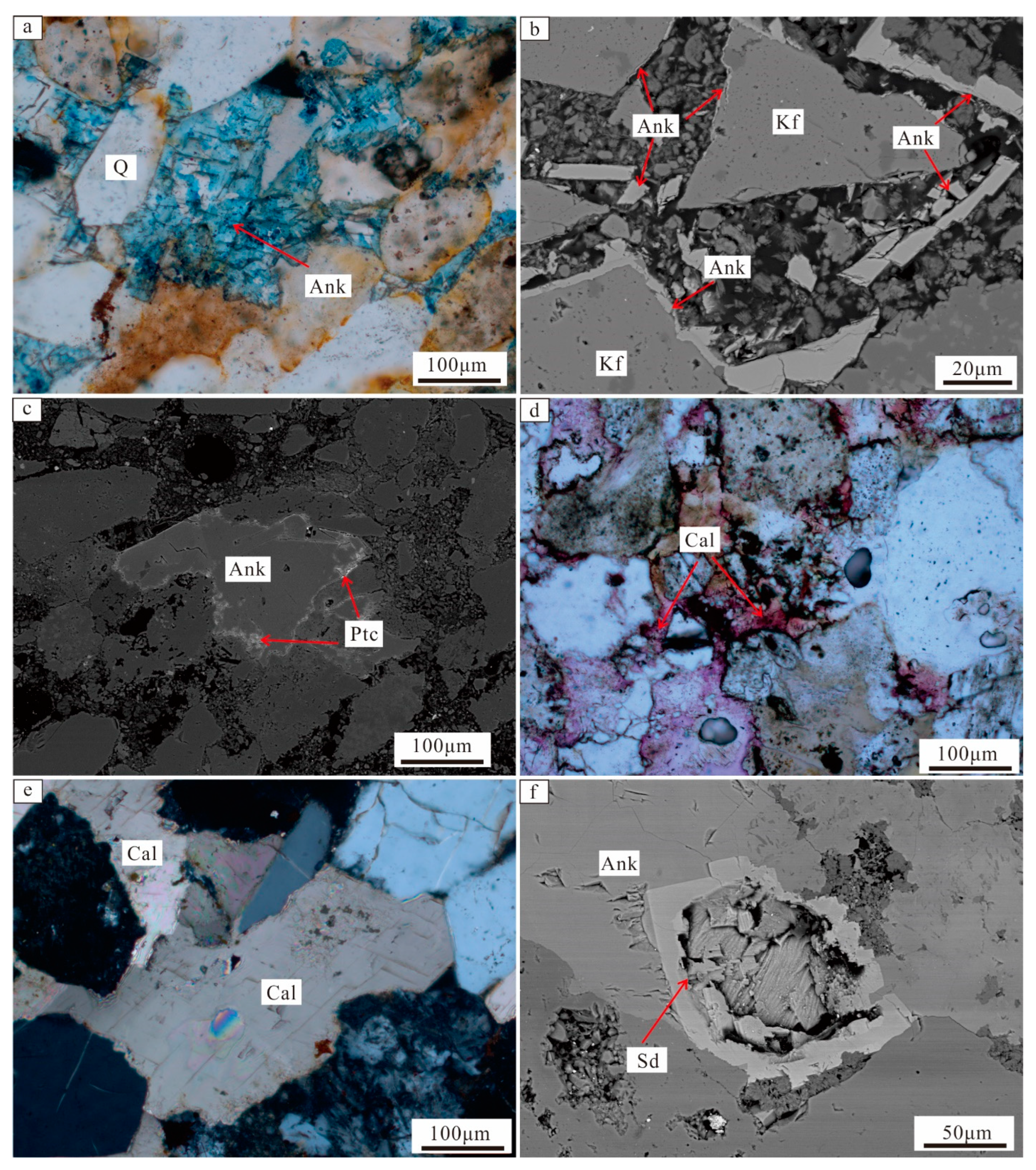
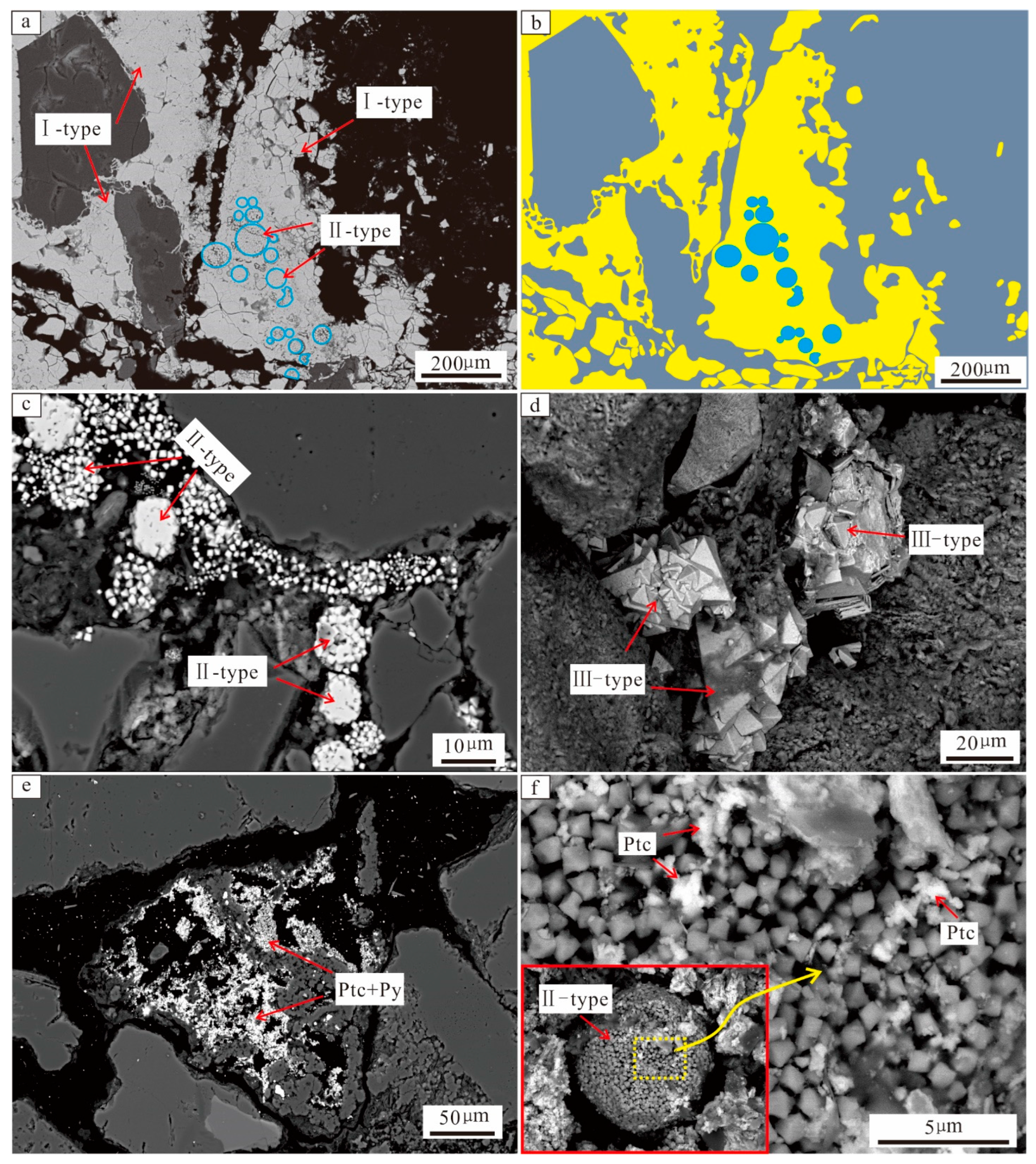

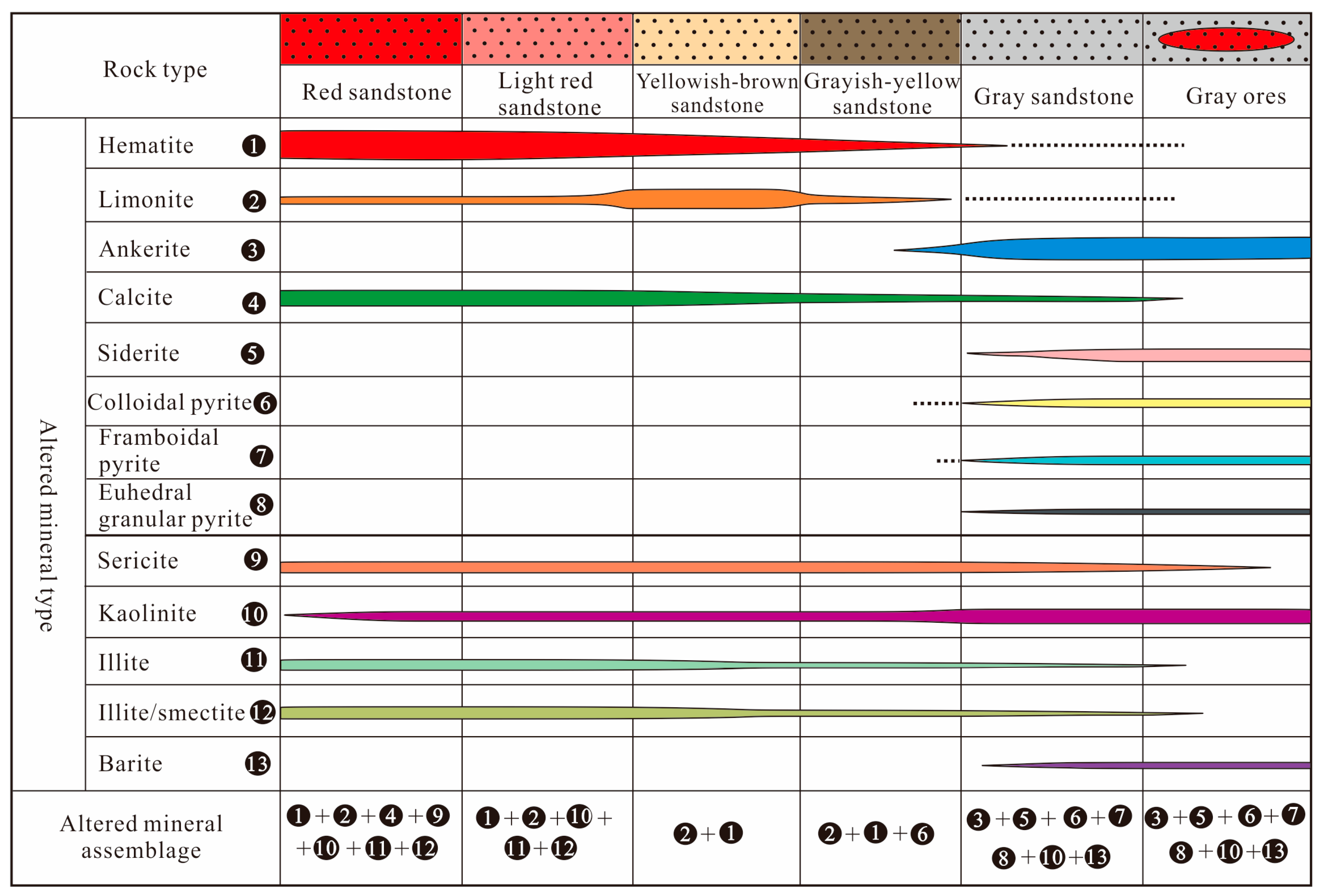
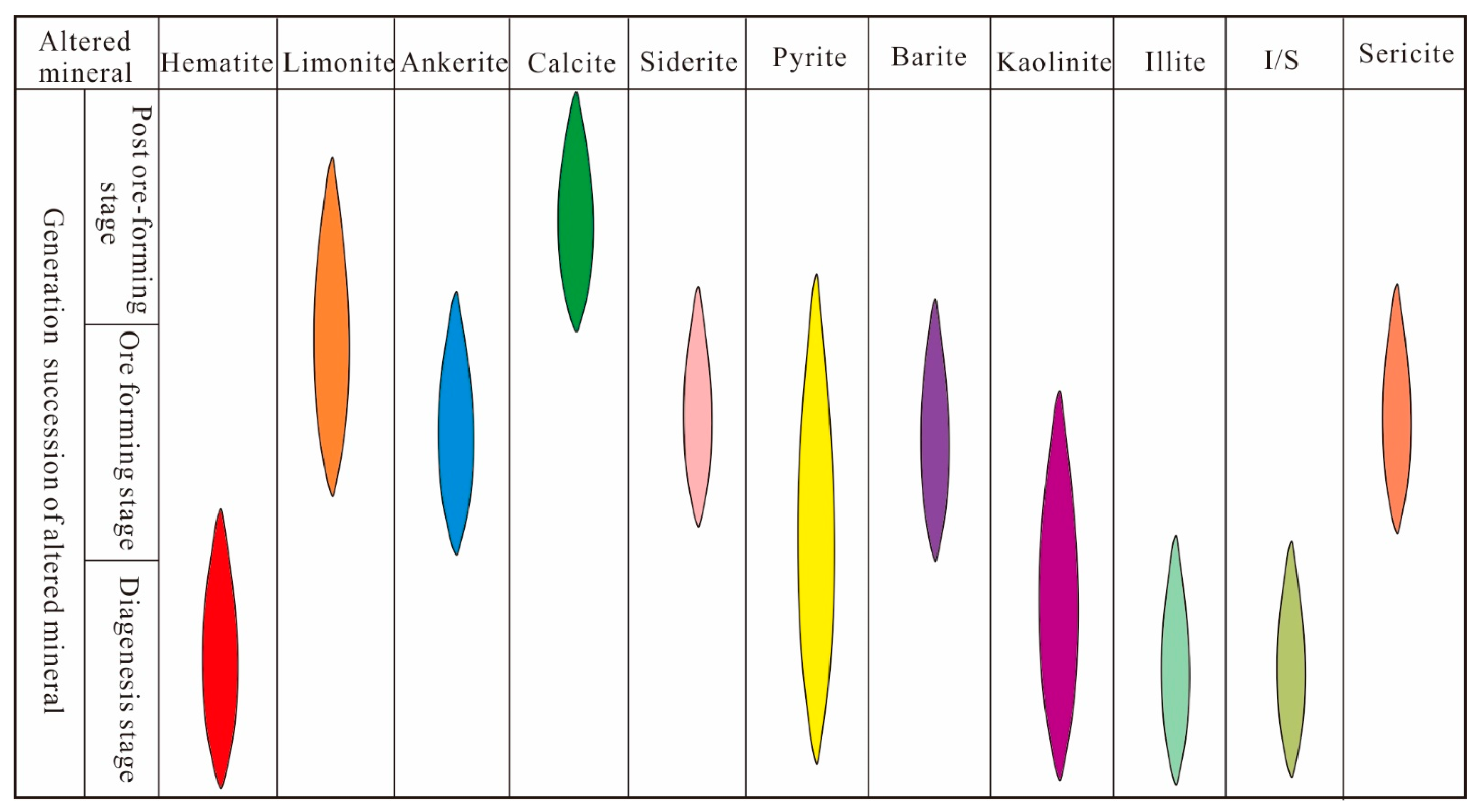
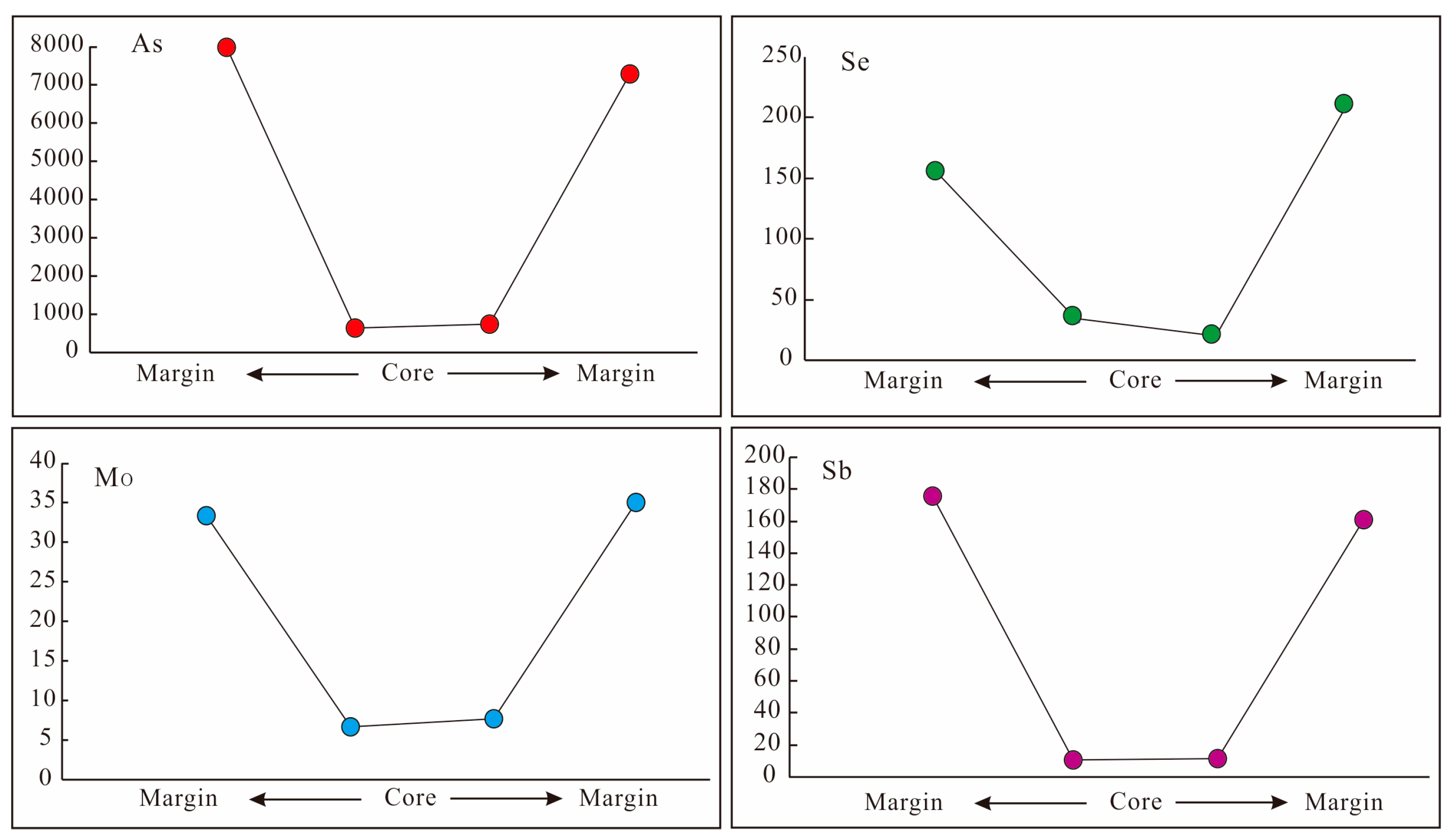
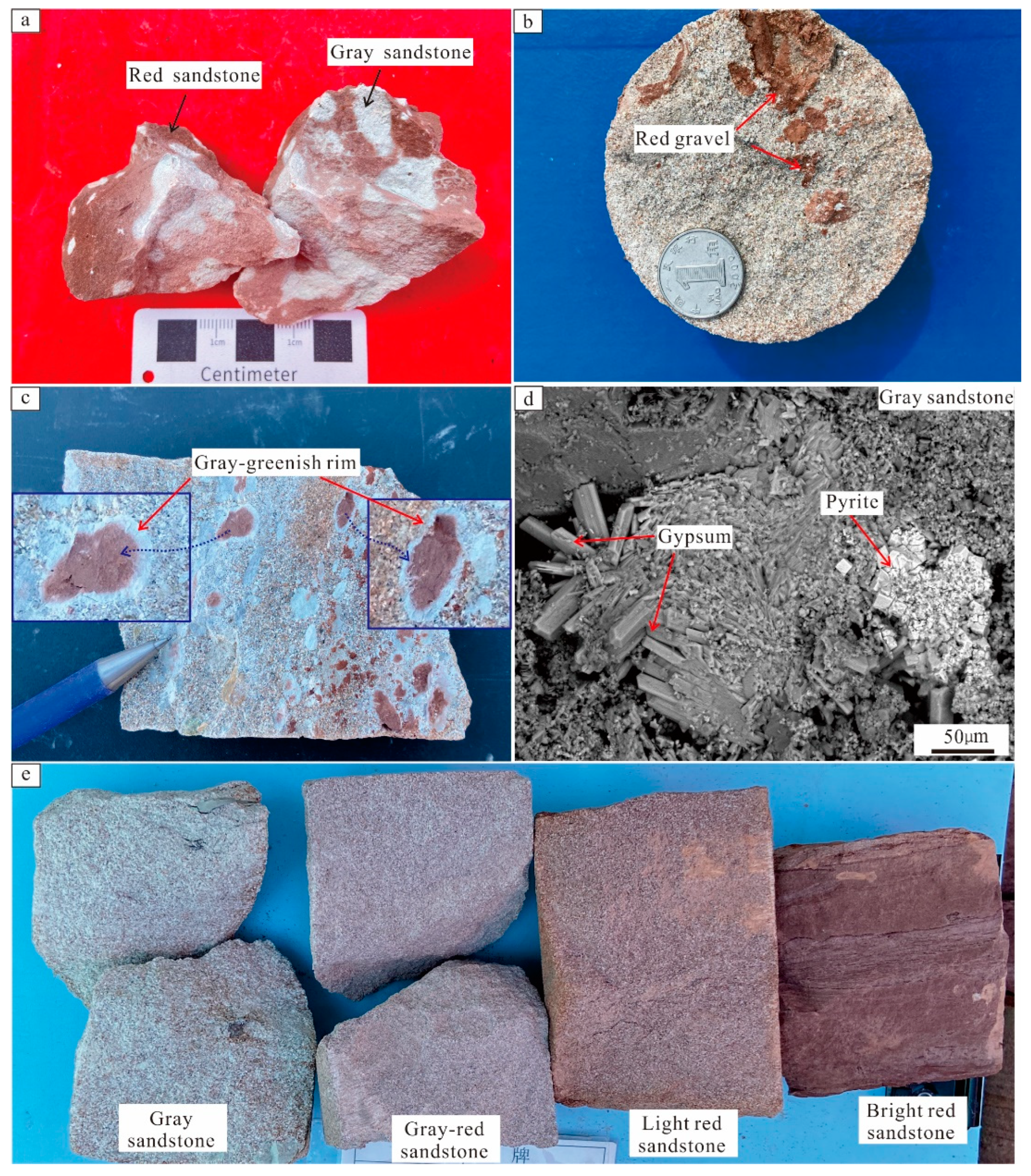
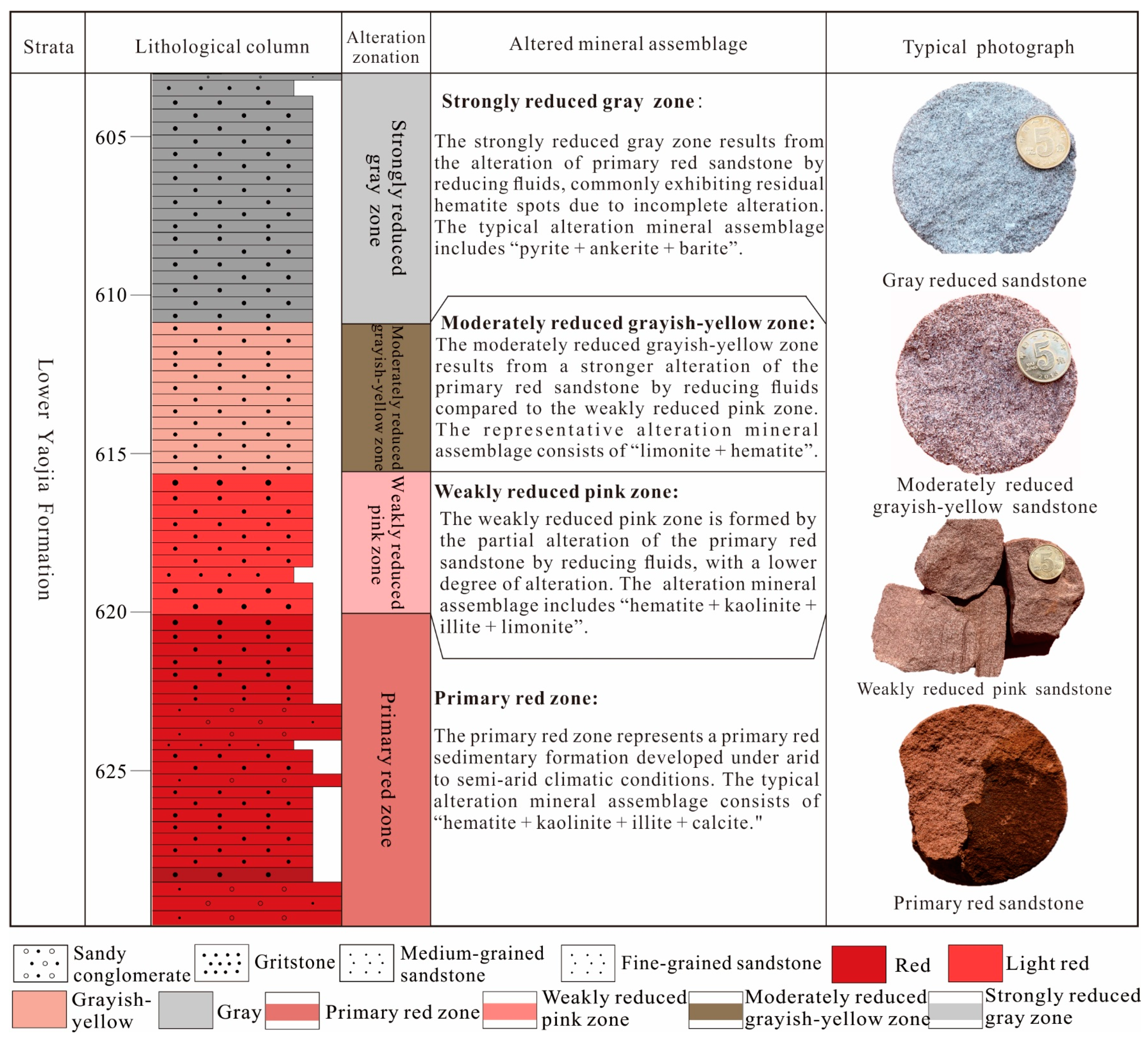
| Sample No. | Lithology | U (×10−6) | Mineral Content (wt%) | |||||||||||
|---|---|---|---|---|---|---|---|---|---|---|---|---|---|---|
| Q | Kf | Pl | Cal | Hem | Py | Ank | Kl | I/S | Ili | Chl | Sme | |||
| L0-2-1 | Red medium-grained sandstone | 2.76 | 55.30 | 6.30 | 13.60 | 7.60 | 5.90 | / | 0.40 | 4.25 | 3.27 | 3.38 | / | / |
| L0-2-3 | Red fine-grained sandstone | 3.63 | 63.10 | 8.90 | 15.50 | 1.00 | 1.10 | / | / | 3.19 | 3.09 | 4.02 | / | / |
| L0-2-6 | Red coarse-grained sandstone | 1.43 | 65.90 | 8.80 | 12.60 | / | / | / | / | 4.95 | 4.83 | 2.92 | / | / |
| L0-2-38 | Red medium-grained sandstone | 2.25 | 76.20 | 5.80 | 6.00 | / | / | / | / | 6.00 | 2.52 | 3.48 | / | / |
| L0-2-36 | Red medium-grained sandstone | 4.63 | 62.60 | 6.00 | 13.10 | 7.00 | / | / | / | 5.38 | 3.92 | 1.90 | / | / |
| L16-1-4 | Light red fine-grained sandstone | 3.22 | 69.10 | 13.70 | 5.40 | 1.00 | / | / | / | 5.18 | 3.13 | 2.48 | / | / |
| L16-1-14 | Light red medium-grained sandstone | 2.2 | 73.40 | 10.70 | 1.50 | / | 2.00 | / | / | 7.44 | 2.73 | 2.23 | / | / |
| L14-3-42 | Light red fine-grained sandstone | 2.25 | 77.20 | 9.00 | / | / | / | / | / | 7.39 | 4.09 | 2.31 | / | / |
| L14-3-44 | Light red fine-grained sandstone | 10.6 | 67.30 | 9.30 | 6.00 | / | 2.40 | / | / | 7.95 | 3.60 | 3.45 | / | / |
| L16-1-13 | Light yellow medium-grained sandstone | 2.2 | 70.10 | 9.30 | 5.60 | 2.20 | / | / | / | 7.68 | 2.94 | 2.18 | / | / |
| L16-1-15 | Yellowish-brown medium-grained sandstone | 1.57 | 78.70 | 9.60 | / | / | / | / | / | 6.20 | 3.63 | 1.87 | / | / |
| L0-12-2 | Yellowish-brown medium-grained sandstone | 5.12 | 71.60 | 6.60 | 10.40 | / | / | / | / | 3.42 | 2.51 | 5.47 | / | / |
| L14-3-26 | Grayish-yellow fine-grained sandstone | 2.04 | 64.10 | 7.30 | 5.60 | / | / | 0.30 | / | 11.35 | 3.18 | 8.17 | / | / |
| L14-3-31 | Grayish-yellow fine-grained sandstone | 2.62 | 73.80 | 7.20 | / | / | / | / | / | 10.58 | 4.54 | 3.78 | / | / |
| L4-5-8 | Grayish-yellow fine-grained sandstone | 5.23 | 85.00 | 6.20 | / | / | / | / | / | 4.49 | 2.29 | 2.02 | / | / |
| L14-3-13 | Gray fine-grained sandstone | 11.3 | 67.70 | 7.60 | 8.50 | / | / | / | / | 8.26 | 4.70 | 3.24 | / | / |
| L14-3-22 | Gray fine-grained sandstone | 1.46 | 69.60 | 7.50 | 5.40 | / | / | / | / | 10.50 | 2.80 | 4.20 | / | / |
| L14-3-27 | Gray fine-grained sandstone | 13.6 | 75.70 | 8.00 | / | / | / | 1.10 | 2.60 | 8.69 | 2.27 | 1.64 | / | / |
| L14-3-34 | Light gray fine-grained sandstone | 3.02 | 70.80 | 7.00 | / | 0.60 | / | 0.90 | / | 11.80 | 5.18 | 3.73 | / | / |
| L14-3-33 | Light gray fine-grained sandstone | 5.63 | 75.70 | 10.90 | / | / | / | / | / | 8.71 | 2.68 | 2.01 | / | / |
| L14-3-38 | Light gray fine-grained sandstone (ore) | 62.8 | 68.90 | 7.20 | / | / | / | / | 1.40 | 13.05 | 3.38 | 6.08 | / | / |
| L0-2-19 | Gray medium-grained sandstone (ore) | 211.4 | 61.70 | 4.20 | 6.10 | / | / | / | 1.10 | 13.72 | 5.38 | 7.80 | / | / |
| L0-2-29 | Off-white coarse-grained sandstone | 12.4 | 74.70 | 6.70 | 3.40 | / | / | / | / | 7.60 | 5.47 | 2.13 | / | / |
| L0-2-24 | Off-white fine-grained sandstone | 14.7 | 72.30 | 6.10 | / | / | / | / | 5.60 | 10.34 | 2.07 | 3.50 | / | / |
| L0-2-45 | Gray fine-grained sandstone | 15.1 | 72.70 | 5.30 | / | / | / | / | 7.60 | 10.51 | 1.87 | 2.02 | / | / |
| L0-12-12 | Gray medium-grained sandstone | 12.2 | 73.80 | 6.50 | / | / | / | / | / | 11.82 | 5.71 | 2.17 | / | / |
| L0-2-25 | Off-white fine-grained sandstone (ore) | 138 | 70.20 | 3.30 | / | / | / | / | / | 16.70 | 4.77 | 5.04 | / | / |
| L0-2-44 | Gray medium-grained sandstone (ore) | 34.4 | 79.50 | 4.50 | / | / | / | / | / | 8.64 | 4.48 | 2.88 | / | / |
| L4-5-12 | Gray medium-grained sandstone (ore) | 1833 | 73.80 | 6.20 | 2.80 | / | / | 3.90 | / | 11.17 | / | 2.13 | / | / |
| L4-5-13 | Gray medium-grained sandstone (ore) | 34.9 | 67.40 | 3.80 | 6.50 | / | / | / | 12.70 | 5.95 | 2.02 | 1.63 | / | / |
| L14-3-41 | Off-white fine-grained sandstone (ore) | 65.2 | 59.20 | 9.40 | / | / | / | / | 18.10 | 8.78 | 3.86 | 0.67 | / | / |
| L4-5-17 | Gray medium-grained sandstone (ore) | 1164 | 69.60 | 6.10 | / | / | / | 1.40 | 2.20 | 14.49 | 4.14 | 2.07 | / | / |
| Sample No. | Lithology | Alteration Zonation | Depth (m) | SiO2 | TiO2 | Al2O3 | Fe2O3 | FeO | MnO | MgO | CaO | Na2O | K2O | P2O5 | LOI | Fe3+ | Fe2+ |
|---|---|---|---|---|---|---|---|---|---|---|---|---|---|---|---|---|---|
| L14-1-1 | Light red sandstone | Weakly reduced pink zone | 569.6 | 77.0 | 0.412 | 11.40 | 1.30 | 0.86 | 0.043 | 0.511 | 0.732 | 0.384 | 3.42 | 0.104 | 3.74 | 0.91 | 0.67 |
| L14-1-2 | 570.6 | 76.3 | 0.277 | 10.30 | 0.94 | 0.95 | 0.042 | 0.827 | 1.700 | 0.361 | 3.37 | 0.062 | 4.74 | 0.65 | 0.74 | ||
| L14-1-3 | 571.6 | 75.2 | 0.473 | 11.20 | 1.20 | 1.20 | 0.036 | 0.757 | 1.380 | 0.342 | 3.43 | 0.071 | 4.62 | 0.84 | 0.93 | ||
| L14-1-4 | Gray sandstone | Strongly reduced gray zone | 572.6 | 77.3 | 0.426 | 11.30 | 0.26 | 0.94 | 0.021 | 0.575 | 1.080 | 0.344 | 3.46 | 0.069 | 4.19 | 0.18 | 0.73 |
| L14-1-5 | 576 | 78.0 | 0.262 | 10.10 | 0.28 | 1.00 | 0.022 | 0.679 | 1.400 | 0.332 | 3.37 | 0.057 | 4.3 | 0.20 | 0.78 | ||
| L14-1-6 | 577 | 77.4 | 0.257 | 11.00 | 0.37 | 0.81 | 0.022 | 0.628 | 1.230 | 0.366 | 3.61 | 0.060 | 4.14 | 0.26 | 0.63 | ||
| L14-1-7 | Gray Sandstone (Ore) | Strongly reduced gray zone | 578 | 78.6 | 0.264 | 9.87 | 0.26 | 0.88 | 0.024 | 0.678 | 1.390 | 0.300 | 3.23 | 0.065 | 4.32 | 0.18 | 0.68 |
| L14-1-8 | 579 | 75.6 | 0.247 | 14.60 | 0.06 | 0.66 | 0.019 | 0.402 | 0.776 | 0.332 | 3.6 | 0.078 | 3.54 | 0.04 | 0.51 | ||
| L14-1-9 | 580.7 | 78.7 | 0.280 | 13.10 | 0.03 | 0.70 | 0.010 | 0.181 | 0.287 | 0.294 | 3.29 | 0.111 | 2.96 | 0.02 | 0.54 | ||
| L14-1-10 | 581.7 | 79.0 | 0.254 | 11.57 | 0.03 | 0.79 | 0.021 | 0.441 | 0.776 | 0.250 | 3.18 | 0.104 | 3.4 | 0.02 | 0.61 | ||
| L14-1-11 | 582.7 | 79.0 | 0.247 | 12.64 | 0.20 | 0.77 | 0.020 | 0.434 | 0.732 | 0.289 | 3.27 | 0.079 | 3.21 | 0.14 | 0.60 | ||
| L14-1-12 | 583.7 | 77.7 | 0.348 | 11.00 | 0.30 | 1.06 | 0.031 | 0.576 | 0.897 | 0.318 | 3.34 | 0.084 | 4.15 | 0.21 | 0.82 | ||
| L14-1-13 | 585.5 | 76.5 | 0.454 | 12.00 | 0.49 | 1.28 | 0.037 | 0.535 | 0.546 | 0.319 | 3.36 | 0.105 | 4.23 | 0.34 | 1.00 | ||
| L14-1-14 | 586.5 | 77.8 | 0.323 | 10.70 | 0.21 | 0.79 | 0.051 | 0.608 | 1.300 | 0.356 | 3.37 | 0.108 | 4.2 | 0.15 | 0.61 | ||
| L14-1-15 | 587.5 | 78.3 | 0.311 | 10.00 | 0.35 | 0.81 | 0.042 | 0.601 | 1.380 | 0.360 | 3.27 | 0.075 | 4.25 | 0.25 | 0.63 | ||
| L14-1-16 | Gray-yellow sandstone | Moderately reduced grayish-yellow zone | 588.5 | 79.4 | 0.323 | 10.80 | 1.06 | 0.34 | 0.025 | 0.388 | 0.619 | 0.379 | 3.43 | 0.077 | 3.06 | 0.74 | 0.26 |
| L14-1-17 | 589.5 | 78.4 | 0.320 | 11.60 | 0.99 | 0.41 | 0.024 | 0.376 | 0.554 | 0.385 | 3.61 | 0.086 | 3.15 | 0.70 | 0.32 | ||
| L14-1-18 | Light red sandstone | Weakly reduced pink zone | 591.1 | 76.0 | 0.397 | 11.90 | 1.31 | 0.52 | 0.032 | 0.448 | 0.642 | 0.363 | 3.52 | 0.123 | 3.6 | 0.92 | 0.40 |
| L14-1-19 | Red sandstone | Primary red zone | 592.1 | 76.2 | 0.369 | 11.40 | 1.12 | 0.65 | 0.053 | 0.533 | 0.867 | 0.343 | 3.43 | 0.100 | 3.79 | 0.78 | 0.51 |
| L14-1-20 | 593.1 | 76.6 | 0.351 | 11.10 | 1.25 | 0.46 | 0.071 | 0.535 | 0.899 | 0.363 | 3.47 | 0.087 | 3.72 | 0.87 | 0.36 |
| Sample No. | Lithology | Alteration Zonation | Depth (m) | U | V | Cr | Co | Ni | Cu | Zn | Re | Pb | Th | Zr |
|---|---|---|---|---|---|---|---|---|---|---|---|---|---|---|
| L14-1-1 | Light red sandstone | Weakly reduced pink zone | 569.6 | 2.75 | 22.00 | 14.70 | 4.68 | 4.29 | 5.11 | 31.10 | <0.002 | 18.20 | 11.60 | 182.00 |
| L14-1-2 | 570.6 | 2.02 | 26.50 | 11.30 | 4.37 | 4.17 | 4.42 | 24.60 | <0.002 | 17.80 | 8.98 | 118.00 | ||
| L14-1-3 | 571.6 | 3.08 | 26.10 | 25.50 | 5.28 | 3.38 | 6.28 | 29.40 | <0.002 | 25.40 | 12.60 | 114.00 | ||
| L14-1-4 | Gray sandstone | Strongly reduced gray zone | 572.6 | 17.10 | 22.40 | 18.80 | 7.55 | 5.60 | 5.54 | 37.20 | <0.002 | 18.30 | 10.40 | 163.00 |
| L14-1-5 | 576 | 19.30 | 22.20 | 21.30 | 4.91 | 4.58 | 3.88 | 31.70 | <0.002 | 22.50 | 6.91 | 104.00 | ||
| L14-1-6 | 577 | 17.30 | 30.40 | 14.60 | 3.07 | 7.85 | 4.65 | 33.10 | 0.01 | 14.10 | 8.31 | 131.00 | ||
| L14-1-7 | Gray Sandstone (Ore) | Strongly reduced gray zone | 578 | 129.00 | 21.70 | 16.40 | 11.43 | 5.94 | 9.10 | 39.80 | 0.01 | 23.60 | 8.05 | 102.00 |
| L14-1-8 | 579 | 986.00 | 41.90 | 27.54 | 19.10 | 6.32 | 9.64 | 46.40 | 0.13 | 20.70 | 6.40 | 132.00 | ||
| L14-1-9 | 580.7 | 1469.00 | 49.40 | 29.18 | 18.70 | 12.80 | 12.03 | 40.50 | 0.72 | 30.60 | 5.64 | 154.00 | ||
| L14-1-10 | 581.7 | 49.00 | 24.60 | 13.89 | 6.93 | 8.01 | 6.07 | 32.70 | 0.00 | 25.60 | 6.51 | 90.80 | ||
| L14-1-11 | 582.7 | 55.40 | 22.80 | 9.72 | 9.97 | 6.23 | 8.91 | 37.10 | 0.04 | 18.20 | 7.45 | 99.90 | ||
| L14-1-12 | 583.7 | 75.10 | 27.20 | 19.50 | 7.48 | 7.43 | 5.80 | 40.40 | 0.02 | 22.80 | 9.26 | 139.00 | ||
| L14-1-13 | 585.5 | 84.40 | 27.50 | 27.70 | 6.44 | 9.21 | 8.81 | 49.30 | 0.05 | 21.30 | 11.10 | 136.00 | ||
| L14-1-14 | 586.5 | 93.30 | 36.80 | 17.30 | 3.94 | 4.74 | 6.23 | 31.40 | 0.05 | 29.40 | 8.33 | 106.00 | ||
| L14-1-15 | 587.5 | 44.50 | 21.30 | 14.10 | 11.70 | 3.98 | 6.12 | 29.80 | 0.01 | 17.50 | 8.66 | 111.00 | ||
| L14-1-16 | Gray-yellow sandstone | Moderately reduced grayish-yellow zone | 588.5 | 9.69 | 20.00 | 15.60 | 4.44 | 4.65 | 3.92 | 32.60 | 0.00 | 14.00 | 7.98 | 129.00 |
| L14-1-17 | 589.5 | 12.65 | 17.90 | 12.50 | 5.70 | 4.50 | 3.08 | 26.60 | 0.00 | 14.50 | 7.56 | 121.00 | ||
| L14-1-18 | Light red sandstone | Weakly reduced pink zone | 591.1 | 1.97 | 13.10 | 18.40 | 2.93 | 4.93 | 5.90 | 34.40 | <0.002 | 17.50 | 9.06 | 144.00 |
| L14-1-19 | Red sandstone | Primary red zone | 592.1 | 1.91 | 24.40 | 12.20 | 3.37 | 3.48 | 2.76 | 27.70 | <0.002 | 15.00 | 9.05 | 128.00 |
| L14-1-20 | 593.1 | 1.80 | 12.00 | 11.20 | 3.47 | 2.42 | 5.04 | 21.90 | <0.002 | 16.80 | 8.71 | 118.00 |
Disclaimer/Publisher’s Note: The statements, opinions and data contained in all publications are solely those of the individual author(s) and contributor(s) and not of MDPI and/or the editor(s). MDPI and/or the editor(s) disclaim responsibility for any injury to people or property resulting from any ideas, methods, instructions or products referred to in the content. |
© 2025 by the authors. Licensee MDPI, Basel, Switzerland. This article is an open access article distributed under the terms and conditions of the Creative Commons Attribution (CC BY) license (https://creativecommons.org/licenses/by/4.0/).
Share and Cite
Tian, M.; Li, Z.; Jia, L.; Liu, J.; Ning, J.; Li, J. Epigenetic Alteration of the Hailijin Sandstone-Hosted Uranium Deposit and Its Indications on Uranium Metallogenesis in the Songliao Basin, NE China. Minerals 2025, 15, 393. https://doi.org/10.3390/min15040393
Tian M, Li Z, Jia L, Liu J, Ning J, Li J. Epigenetic Alteration of the Hailijin Sandstone-Hosted Uranium Deposit and Its Indications on Uranium Metallogenesis in the Songliao Basin, NE China. Minerals. 2025; 15(4):393. https://doi.org/10.3390/min15040393
Chicago/Turabian StyleTian, Mingming, Ziying Li, Licheng Jia, Jungang Liu, Jun Ning, and Jimu Li. 2025. "Epigenetic Alteration of the Hailijin Sandstone-Hosted Uranium Deposit and Its Indications on Uranium Metallogenesis in the Songliao Basin, NE China" Minerals 15, no. 4: 393. https://doi.org/10.3390/min15040393
APA StyleTian, M., Li, Z., Jia, L., Liu, J., Ning, J., & Li, J. (2025). Epigenetic Alteration of the Hailijin Sandstone-Hosted Uranium Deposit and Its Indications on Uranium Metallogenesis in the Songliao Basin, NE China. Minerals, 15(4), 393. https://doi.org/10.3390/min15040393






